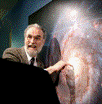Department of Physics and Astronomy: Publications and Other Research
Date of this Version
11-1-2007
Abstract
A combined analysis of the profiles of the main broad quasar emission lines in both Hubble Space Telescope and optical spectra shows that while the profiles of the strong UV lines are quite similar, there is frequently a strong increase in the Lyα/Hα ratio in the high-velocity gas.We show that the suggestion that the high-velocity gas is optically thin presents many problems.We show that the relative strengths of the high-velocity wings arise naturally in an optically thick BLR component. An optically thick model successfully explains the equivalent widths of the lines, the Lyα/Hα ratios and flatter Balmer decrements in the line wings, the strengths of C III] and the λ1400 blend, and the strong variability in flux of high-velocity, high-ionization lines (especially He II and He I).


Comments
Published in The Astrophysical Journal, 669:126–134, 2007 November 1. Copyright © 2007 The American Astronomical Society. Used by permission.